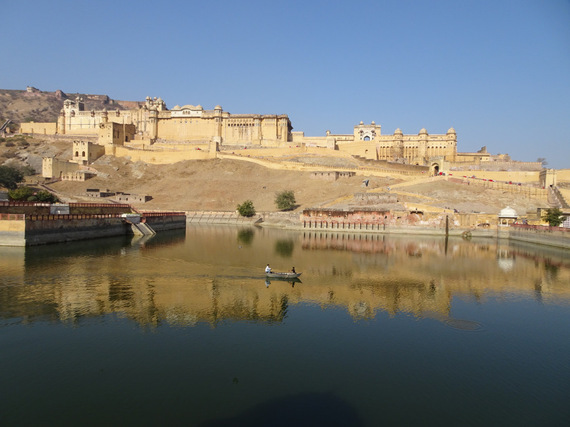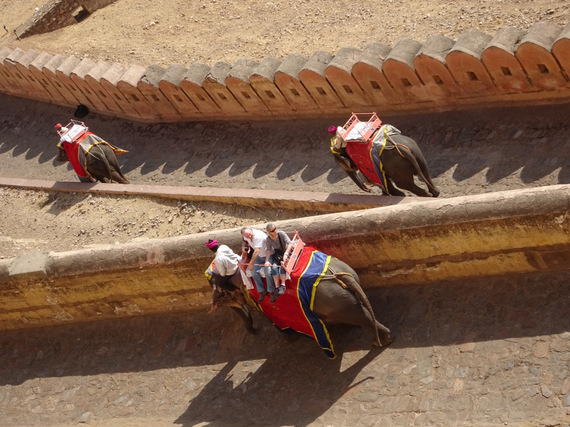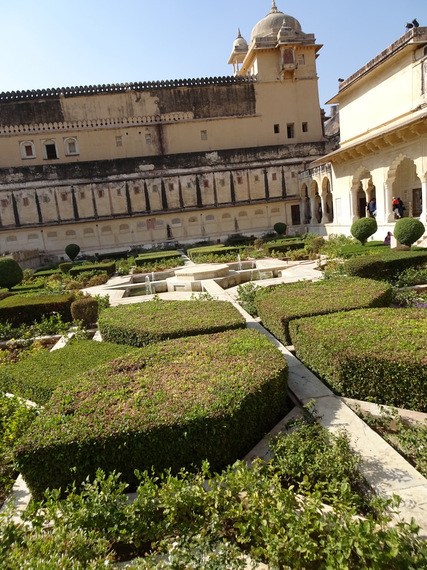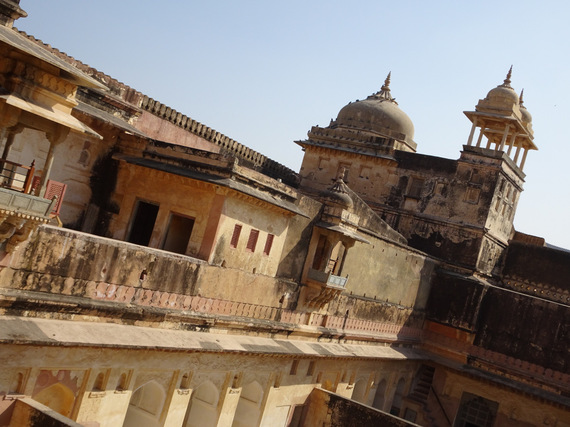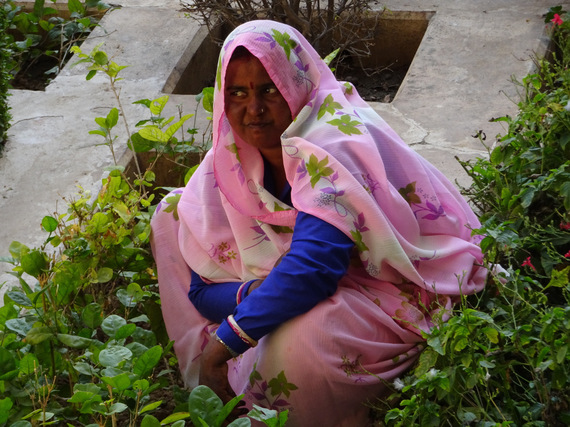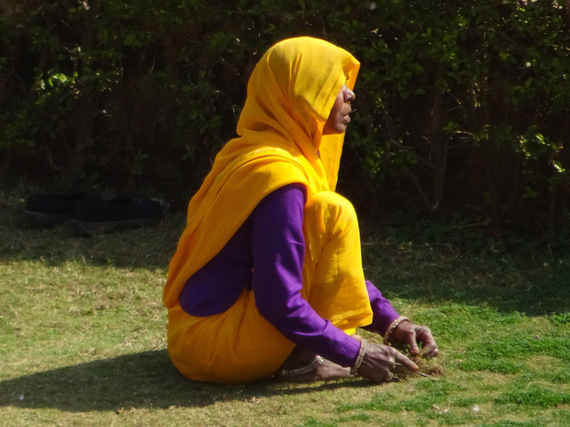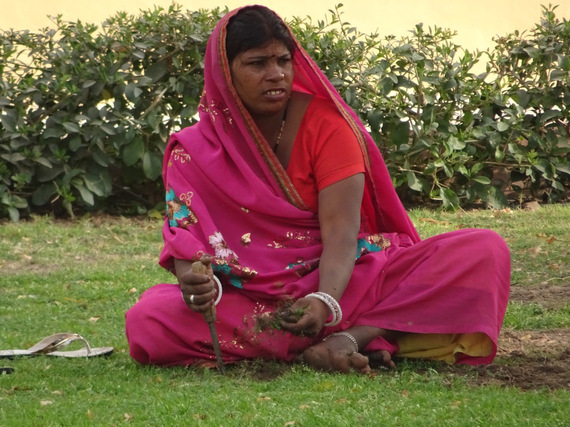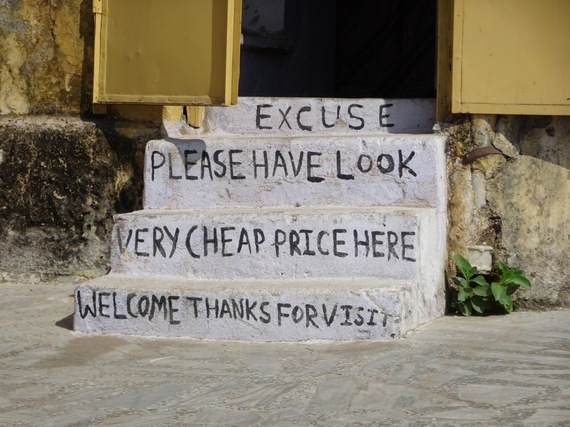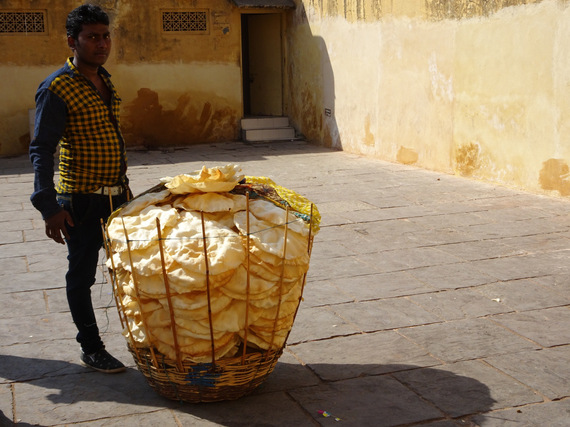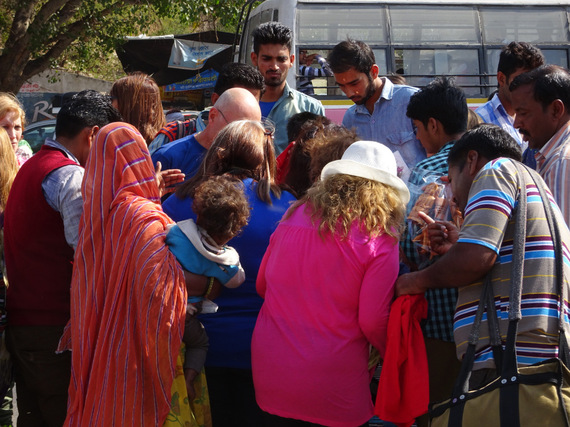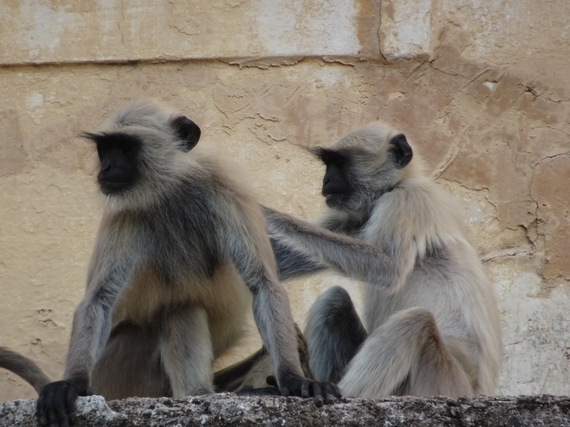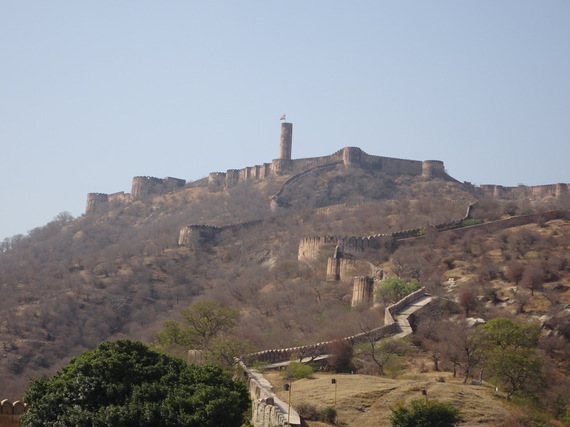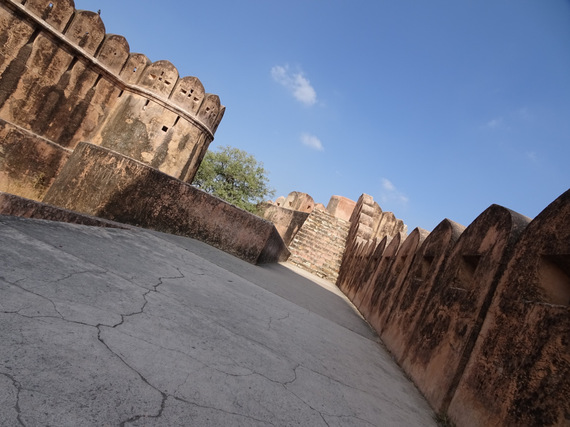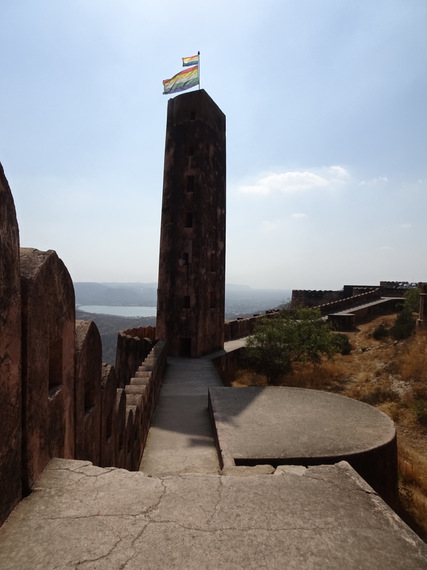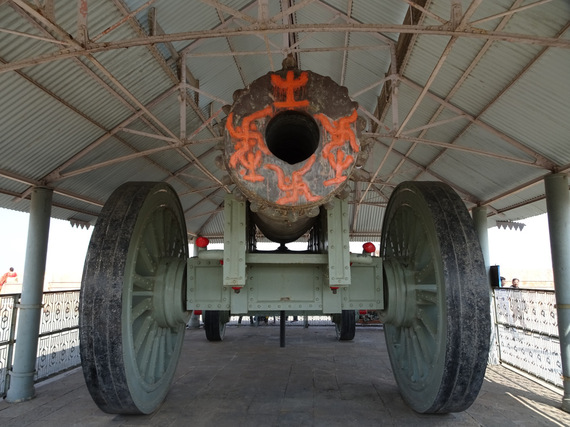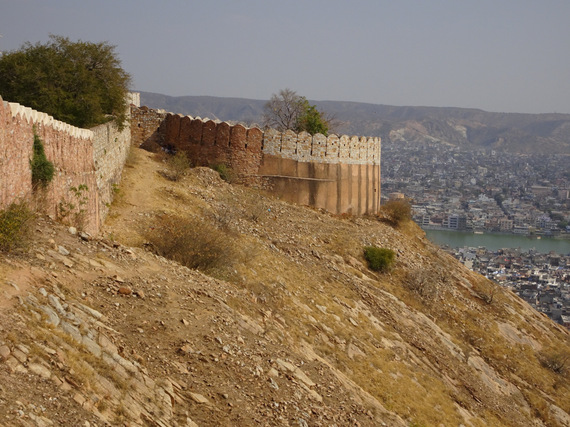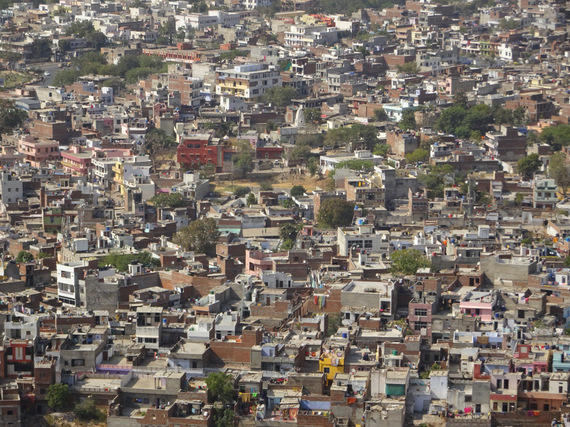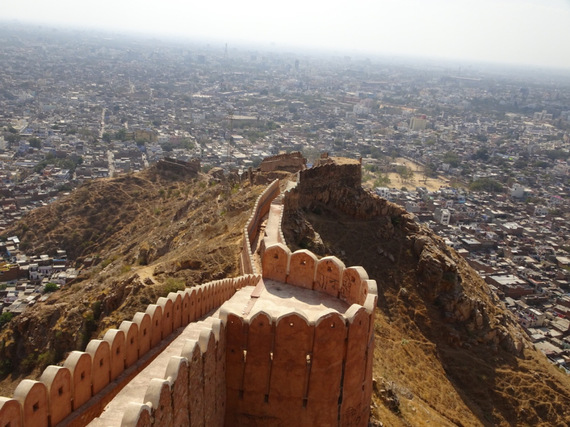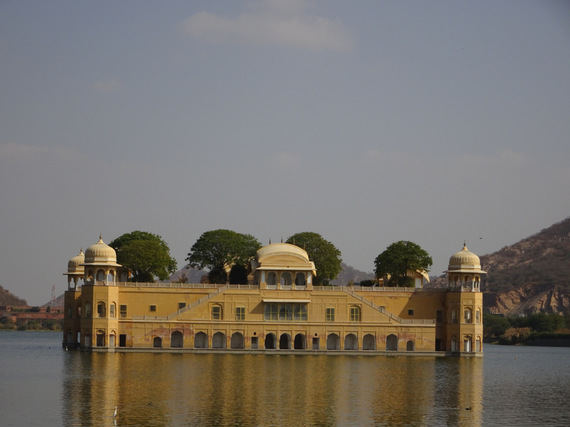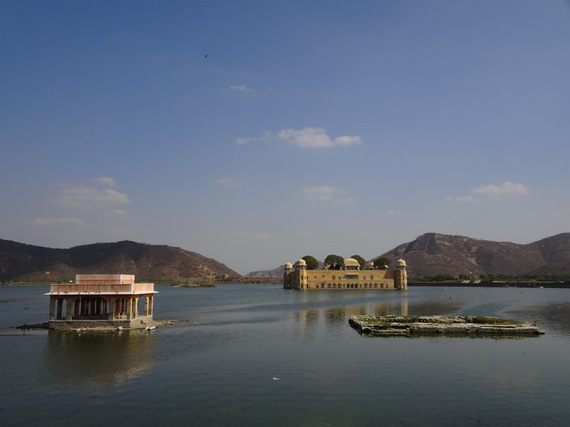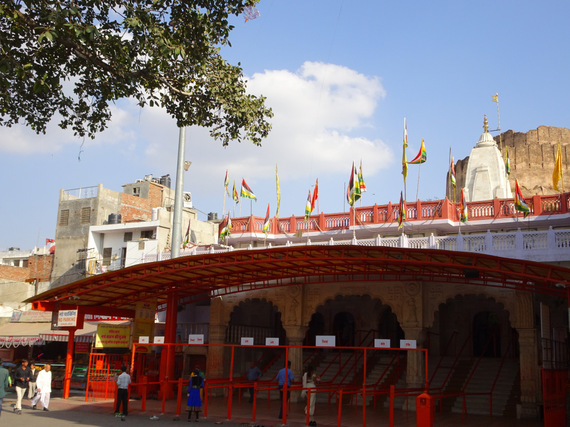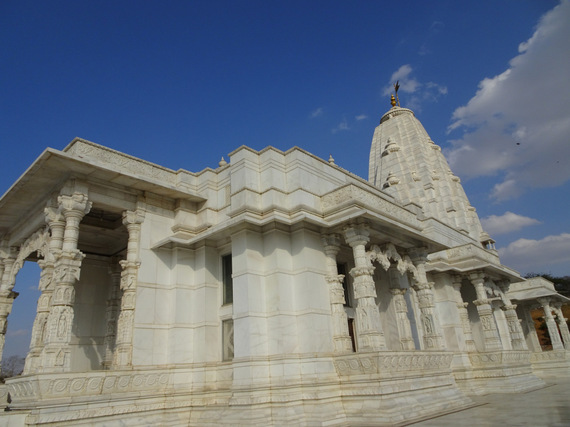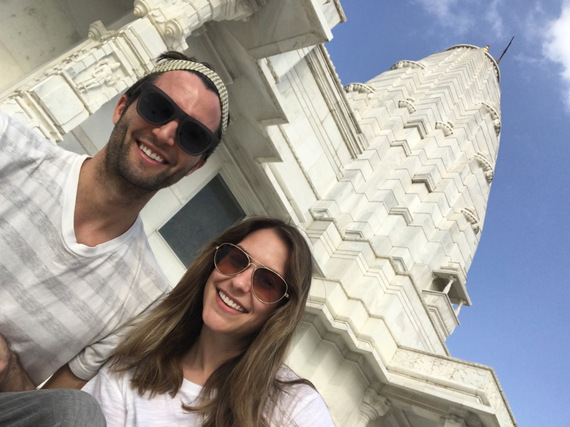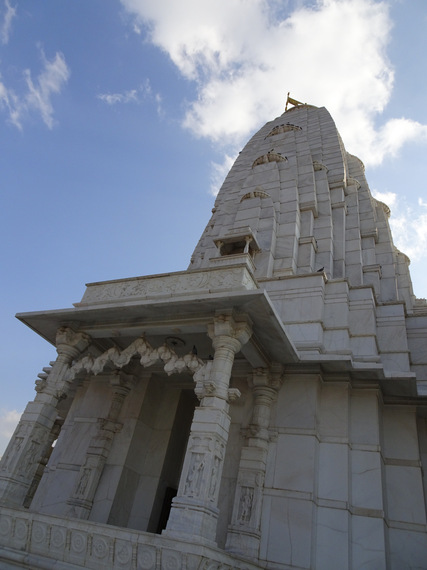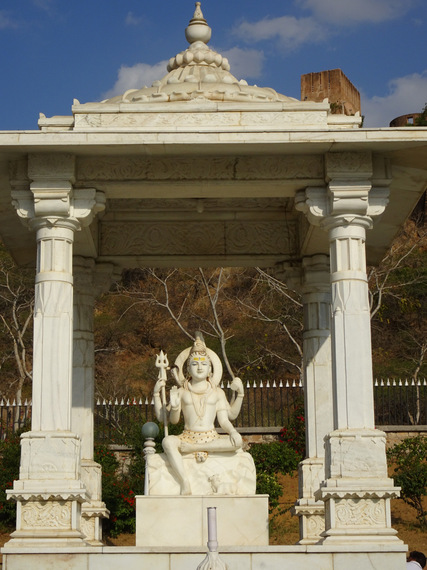It's always been known to me that Jaipur is referred to as the Pink City but I never knew why, until today. In 1876, the Prince of Wales visited India on a tour. Since pink denotes the color of hospitality (did you know that? I sure didn't), Maharaja Ram Singh of Jaipur painted the whole city pink to welcome his royal guest. The tradition has been sincerely followed by the residents who are now, by law, compelled to maintain the pink color. And pretty in pink it sure was.
To begin our day was the Amber Fort, which is located high on a hill in Amer, a town with an area of four square kilometers. Establishment of this fort started in the 16th century but wasn't completed until the 18th century with the efforts of three consecutive Kings. It was originally the capital of Rajasthan before moving to Jaipur in 1727. The magnificent fort is made up of a royal palace, built from red sandstone (although some say yellow sandstone and it definitely looks more yellow than red), white marble and divided into four main sections, each with its own courtyard. With its large ramparts, series of gates and cobbled paths, the fort overlooks the Maota Lake at its forefront.
In order to get to the top, you can walk for free, take a jeep for 300 rupees or ride an elephant for 900 rupees. We decided to walk. Taking an elephant seemed a bit inhumane and a jeep just seemed lazy. The fort was beautiful. After about 45 minutes of exploring, we ran into a few "security guards" that were dressed in the whole shebang - hat, pants, shirt, shoes. One of the "security guards" asked us where we were from and of course we happily engaged in conversation. He wanted to take us to the top for a photo opportunity so we followed. How touristy of us. He then started giving us the history on Amber Fort, even though we didn't really want it nor did we ask (thanks to Google, we've got it covered). We eventually caught on and he wasn't really a "security guard" but he was a guide in disguise. Now say that ten times. Guide in disguise, guide in disguise, guide in disguise - okay, I'll stop. How very very sneaky of him. We thanked him and walked away because we sure weren't going to pay for his services when they weren't genuine to begin with. It's little acts like this that we have become all too familiar with. As my pops always said, you can't bullshit a bullshitter. Besides that encounter, it was a lovely two hours roaming the grounds and admiring all the extensive walls that were built for protection throughout the small city of Amer.
All over India, especially inside the various forts, palaces and other historical sites, women are always gardening...
And men are always trying to get you to buy something...
And monkeys are always looking out for one another...
Next up was Jaigarh Fort. This almost-intact fort is surrounded by huge battlements and is connected to the Amber Fort, with subterranean passages. Originally built to secure Jaipur City and the Amber Fort from warlords and rivals, the Jaigarh Fort is architecturally similar, and offers a panoramic view of the city of Jaipur. The fort houses the world's largest cannon on wheels (which was pretty cool), a majestic palace complex and the assembly hall of the warriors known as 'Shubhat Niwas' along with a museum and an armory.
Here is a view of the Jaigarh Fort from the Amber Fort...
We bought our tickets like good civilians, wandered around, enjoyed the views and went to see the "world's largest cannon on wheels". There was a "security guard" there too who checked our tickets and then started walking around with us. From the very beginning, I said "no thank you, we don't want a guide. We prefer to see on our own". I was very sweet, don't worry. I puckered my lips and batted my eyelashes so I didn't come across as a rude American. He said "I'm no guide, I just like to help". It didn't matter how many times we said no thank you or in how many different languages, they still insist. I ignored him but of course Vinny wouldn't hurt a fly so he kept indulging in conversation. About ten minutes later, the "security guard" literally said "tip as you like". Our mouths dropped. This whole time we've said no thank you, you then willing give us information that isn't wanted and then have the nerve to say "tip as you like". Nope sorry. To us its seems disrespectful and rude but I truly believe it's just how they are and for that, we can't really judge. Everyone is hustling to put food on the table and a roof over their head.
The last of the three main forts was Nahargarh Fort. Nahargarh Fort was built in 1734 by Maharaja Sawai Jai Singh II, founder of Jaipur, on the Aravalli hills, as a retreat place. Nahargarh Fort is connected to the Jaigarh Fort through its fortifications. It is believed that the construction of this fort was obstructed by the spirit of a Rathore prince, Nahar Singh Bhomia. However, the spirit was pacified when a temple dedicated to him was built inside the fort. Sawai Ram Singh renovated this fort in 1868. The views here were incredible. You basically had a 360 degree look at Jaipur.
After Nahargarh Fort, we quickly stopped by Jal Mahal. Literally meaning 'Water Palace', Jal Mahal is located amidst the Man Sagar Lake and was constructed in 1799. The beauty of the palace lies in its location as it is standing in the center of the lake. The palace architecture boasts of a typical Rajput and Mughal style which is quite similar to that of Amber Fort. Made in red sandstone, Jal Mahal is actually five-stories where only the top story is visible (the rest are submerged under water). You can't visit the palace inside but the views from the outside were enough for us. Mr. Bahadur told us that Jal Mahal was built first then they added the manmade lake (in case you were wondering how this palace came about).
It was about 2pm by this point and we were starving. Mr. Bahadur took us to a nice restaurant for lunch where there was a father and son performing local Rajasthani song and dance. They were also dressed in traditional Rajasthani outfits. I wanted to take a photo but didn't want to tip so I passed. Sorry guys.
The last two sights on our list were temples. However, temples are generally closed in India from 12pm-4pm, give or take a few. It was about 3pm so Mr. Bahadur was trying to convince us to go to the textile factory first for a demonstration since we had time to kill. We are pretty sure he receives a commission on anything we buy so we politely said no thank you - mainly because we really didn't have a desire not because we didn't want to help a friend out. This also happened in Varanasi with Shukla when he took us to the silk factory but we were young infants at that point and didn't understand the Indian culture. Now we know. Muahahahahaha. We decided to take our chances on the temples and head that way anyways. Good thing we did because they were both open.
First was the Ganesh Temple. This was your typical Hindu temple. Not so aesthetically appealing on the outside yet extremely holy in it's spiritual importance on the inside. Lord Ganesh is an elephant headed deity in Hinduism and is worshipped among all deities because he is considered as the God of auspiciousness in Hinduism as well as God of wisdom, knowledge and wealth. Lord Ganesh is believed to be the older son of Lord Shiva. Throughout India, you will notice a Lord Ganesh, or elephant like image, everywhere - at the entrance of temples, on walls of restaurants, randomly throughout the city, etc. Hindus believe that if Lord Ganesh is present they will have good luck, good wealth and good health. For a lack of a better comparison, it reminds me of a mezuzah in the Jewish religion.
Second was the Birla Mandir Temple. The Birla Temple, originally known as Lakshmi Narayan Temple, is situated below the Moti Dungri Fort in Jaipur (and a short three minute walk from the Ganesh Temple). Dedicated to Lord Vishnu and Goddess Lakshmi, this temple is a proud architectural landmark of Jaipur. Built in pure white marble, the Birla Temple is unlike the traditional ancient Hindu temples, and is built with a modern approach. Inside this magnificent shrine, beautifully sculpted idols of Lord Vishnu and Goddess Lakshmi, as well as other Hindu Gods and Goddesses, can be seen. Delicate carvings of Hindu symbols, and ancient quotes from the Geeta and the Upanishads ornament the walls of this fascinating temple. One can also recognize the mythological events engraved on the walls. Apart from the religious idols, pictures and figures of several religious saints, philosophers and historical achievers, like Socrates, Buddha, Zarathustra and Confucius, are also included in the temple. A work of art, this temple truly represents architectural beauty.
Birla Mandir was the first temple we have seen in the seventeen days we've been in India that made our mouth drop. It was stunning. The way the sun hit the white marble was captivating. What made this even better was a local Indian family of about six who wanted to take a photo with us. Of course we willingly said yes. One photo turned into five photos which turned into roughly twenty photos. Everyone wanted a selfie with just them, then they wanted a group photo, then the boys wanted one, then the girls wanted one, then the parents wanted one. It was hilarious. I'm used to smiling but boy did my mouth hurt after. I, in turn, asked to take a selfie with them.
What a fulfilling eight hours of sightseeing we had. We met some shady people and we met some lovely people. I still wasn't feeling 100% so we went back to our AirBnB and chilled for a few hours before walking to dinner at another rooftop restaurant called Kalyan. It was good but not as satisfying as our last two dinners. You win some and you lose some, that's life.
Jaipur sure has tremendous charm to it. I think I'm falling in love...
